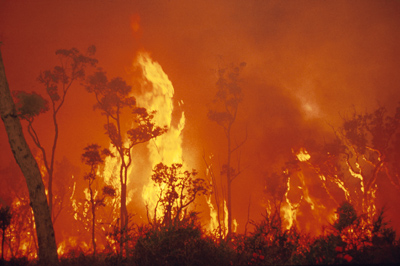






Anthony Moore 153588
What are
the alternatives?
In Australia, the most relevant alternative to the
traditions of western fire management is clearly the indigenous tradition. In
some parts of northern Australia indigenous fire management has continued
relatively unbroken for thousands of years (Morris 1996). As such, traditional
fire management in these areas has been quite well described.
In the
seasonal high rainfall savanna areas burning generally began as early as
possible following the wet season, with higher, drier areas burned first, along
with margins of monsoon forest to create a fire break protection against later,
high intensity fires. Fire continued to be applied as the landscape dried
through the dry season, culminating in the burning of floodplains and along
creek lines late in the year (Whitehead et al. 2003). As a result, landscapes
were a mosaic of areas at different stages of regeneration, the majority having
being burnt at least once within a 2-3 year period (Morris 1996).
Under
this regime, there is little opportunity for the build-up of dead organic matter
required to fuel extremely high intensity fires. Indeed, the seasonal climate of
the tropics dictates that exclusion of fire is not an option; the rapidly
growing grasses of the wet season quickly dry out to fuel the fires of the dry
season, starting either by anthropogenic ignition or lightning. Indigenous
people do not add fire to the tropical landscapes but simply alter the timing of
when it occurs (Morris 1996).
A large proportion of land in Australia’s
savannas and semi-arid regions is owned and managed by indigenous people now
largely living in widely separated towns and communities. It has been suggested
that if effective, quality fire management is to be applied across these
regions, people must return to live on the land (Yibarbuk 1998). This suggestion
also reflects a contrast between the practical application of knowledge in
western and indigenous knowledge systems. In western culture, fire management is
generally undertaken only by officially trained experts, while for indigenous
lands, the responsibility is considered to lie with the entire community – if
this community were well distributed then group-based participation could
greatly improve fire management (Berkes 1998).
Double click
to edit










In fact,
traditional indigenous burning was not limited to the tropical north. There are
strong indications that the Eucalypt forests of eastern Australia were far less
dense at the time to European colonisation and the cessation of traditional fire
management led to rapid changes in vegetation communities (Jurskis 2005).
Increasingly, western science shows agreement with the traditional practices,
with prescribed burns widely utilised in these forests to reduce the risk of
extreme wildfires (Penman et al. 2007).


















